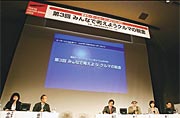Automobile Taxation 2005
Automobile Taxation Reform Forum |
|
|

International Conference Room |
 This is the third year for this Forum, which discusses the problems in Japanese automobile taxation. To mark the midpoint of its five-year plan, the Forum brought two new innovations this year. At certain points during the panel discussion, the audience was invited to press buttons to respond to a survey which was analyzed on the spot. Audience members and panelists were also invited to give their opinions on the ideal form of automobile taxation so that the Forum could prepare a set of interim recommendations. This is the third year for this Forum, which discusses the problems in Japanese automobile taxation. To mark the midpoint of its five-year plan, the Forum brought two new innovations this year. At certain points during the panel discussion, the audience was invited to press buttons to respond to a survey which was analyzed on the spot. Audience members and panelists were also invited to give their opinions on the ideal form of automobile taxation so that the Forum could prepare a set of interim recommendations.
The event began with comments from Terry Ito, Kayoko Miyata, Nobuteru Ishihara, and Masahiro Sugiyama. This was followed by a question for the audience: "If you buy a new car for ¥1.8 million and drive it for three years, how much tax will you pay?" Of the 275 members of the audience, 16 replied "about ¥150,000," 94 said "about ¥300,000," and 165 said "about ¥500,000." The right answer was ¥524,100. Using this as a base, the audience was then asked if it thought automobile taxes were "too high," "just right" or "too low," and 233 said that they were indeed "too high" (89%).
The discussion then moved to the fact that Japan has nine different forms of automobile taxes, a rather odd system by any measure. When purchasing a car, one gets hit with a double bite for automobile acquisition tax and consumption tax. Then there are gasoline taxes against which consumption tax is also charged. Why, the Forum asked, are Japanese automobile taxes so high compared to other countries?
Then the topic turned to how these tax revenues are used, highlighting government plans to take the surplus from taxes earmarked for road construction, something that only drivers pay, and reallocating them to the general revenues or to environmental taxes. This led to another audience question: "Since there are surpluses, should the provisional tax rate be lowered?" 207 members of the audience (87%) said yes.
Summing up the survey responses and panelists opinions, Naotsugu Mihori said, "If taxes earmarked for road construction are to be reallocated, they should be returned to their original rates," and proposed including this in the interim recommendations, an idea that was widely applauded. |
|
|
 |
Nobuteru Ishihara,
Member of the House of Representatives |
|
|
 |
Kayoko Miyata, Freelance Newscaster |
|
|
|
 |
Terry Ito, Producer |
|
|
 |
Naotsugu Mihori, Motor Journalist |
|
|
Masahiro Sugiyama,
Professor, Waseda University Graduate School |
|
|
|
|
|
|